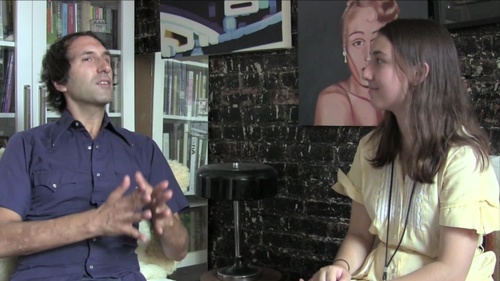Nick Hallett: Voice & Light Systems, Part Four: Auroville
Nick Hallett—singer, composer, and downtown impresario—creates a four-part series, as part of New Museum’s newly launched RE:NEW RE:PLAY Performance Residency Series, at the Museum’s theater connecting the human voice to multimedia ritual.
Hallett’s monthlong residency ended with a new multimedia ritual created by Auroville, a “tribute band” to the experimental community dedicated to the guru Sri Aurobindo on the southeastern coast of India, founded by his spiritual partner, known as the Mother. Auroville was performed as an immersive, audiovisual travelogue by a collective of musicians and multimedia artists, featuring Hallett, Ana Matronic, Seth Kirby, Zach Layton, Brock Monroe, and Ray Sweeten. A wraparound projection design set the stage for Hallett’s chanting and electronic music while Matronic performed on the glass armonica, an integrated series of glass bowls, popularized as a musical instrument by Benjamin Franklin. Hallett and Matronic, alongside performing artists Caitlin Kirby, Renée Soucy and Juan-Carlos Castro, acted as celebrants for a universal ritual of art, devoid of specific icons or dogmas (much like its namesake in India). Sound design and electro-acoustics by Jeff Cook. The performance made heavy use of stroboscopic imagery.
In collaboration with a rotating cast of performers and artists, Hallett presented original music and performance alongside new interpretations of celebrated vocal works by Meredith Monk and Karlheinz Stockhausen. The singing voice was seen here in its rawest state, stripped of its language-based sensibilities, and more as a flexible instrument of sound, capable of producing protosemantic, acoustic phenomena. As such, concepts of drone, repetition, and improvisation prevail over the tropes of traditional song. Each evening was staged using pure light, illuminated objects, and projection methods derived from structuralist film and the psychedelic lightshow to create a live, interdisciplinary synthesis of sound and image. Taking from John Cage’s maxim that “art should not be different than life, but an action within life,” “Voice & Light Systems” revisited the Zen-Buddhism-inspired methodologies popular among Western artists during the 1960s and ’70s as ritual practices in and of themselves, envisioning their scores much as sacred texts in a pre-literary culture, to be rendered as expressions of devout “art consciousness.” With this experimental tradition as a starting point, Hallett began to develop new work for contemporary contemplation, with the voice—the most basic instrument of artistic expression—at its core.
